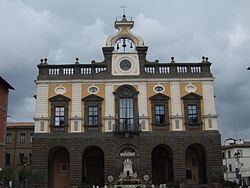Elevation 227 m (745 ft) Time zone CET (UTC+1) Area 84 km² | Demonym(s) Nepesini Postal code 01036 Local time Friday 12:05 PM | |
 | ||
Weather 19°C, Wind NE at 5 km/h, 49% Humidity | ||
Nepi (anciently Nepet or Nepete) is a town and comune in Italy in the province of Viterbo, region of Lazio. The town lies 30 kilometres (19 mi) southeast of the city of Viterbo and about 13 kilometres (8 mi) southwest from Civita Castellana.
Contents
Map of 01036 Nepi Province of Viterbo, Italy
The town is known for its mineral springs, sold and bottled under the Acqua di Nepi brand throughout Italy.
History
The region was already occupied in the 8th century BC; neighbouring Pizzo had been occupied in the Bronze Age. Nepet became Roman before 386 BC, when Livy speaks of it and Sutrium as the keys of Etruria. In that year it was surrendered to the Etruscans and recovered by the Romans, who beheaded the authors of its surrender. It became a colony in 383 BC. It was among the twelve Latin colonies that refused further help to Rome in 209 BC. After the Social War it became a municipium. It is hardly mentioned in Imperial times, except as a station on the road (Via Amerina) which diverged from the Via Cassia near the modern Settevene and ran to Amelia and Todi.
In the 8th century AD it was the seat of a duchy for a short while. During the late 9th to early 10th century, it was, along with much of central Italy, threatened by the Saracens.
